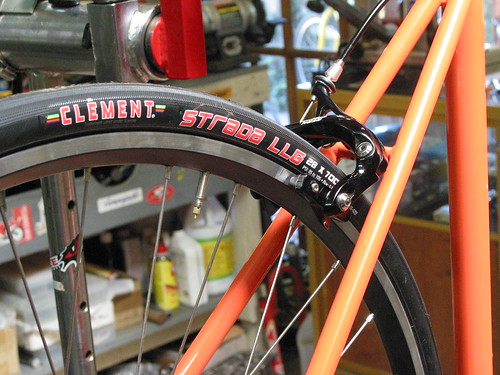By blackmountaincycles,
Filed under: Uncategorized
The road surface is very varied. At the beginning of the ride, there is a bridge over Lagunitas Creek that has big, deep, wide expansion joints on both sides of the bridge. I repair many a pinch flat from riders coming into town with skinny tires and insufficient pressure. There is a too low pressure. Riding through Inverness Park and Inverness, the road is in pretty good shape since it was repaved a few years ago. However, the road condition deteriorates the further north one pedals and there is even an option of pedaling out on a dirt road.
It’s on these roads with broken pavement and undulating surfaces that I started thinking more about tire pressure. And a few months ago, I started thinking about tire pressure on road bikes in terms of air pressure in shocks on a full-suspension bike. Too much air pressure in a rear shock or fork and you’re just banging into rocks and ruts and you might as well be on a fully rigid bike. Not enough air in your fork or shock and you’ll be bottoming out and wallowing too deep in the suspension’s travel.
Applied to a road bike’s tires, too much air pressure and the ride is harsh, amplifying every road imperfection. Not enough air and you’ll be stopping every time the road surface crumbles to chunks to repair pinch flats. Now this might sound elementary, but I kind of like the analogy of setting the air pressure in your road tires much like you would on a full suspension bike. Maybe that’s what it takes for folks to understand the interaction of road tires with the road surface.
Whether you are on a full-suspension bike or a road bike, you want your tires to stay in contact with the road. The only way to be fast is to have your tires in constant contact with the road surface. If the tires are bouncing into the air (even for a micro second and many micro seconds add up on a long ride) and you are pedaling to propel the bike forward, your energy expended to make the bike move forward is wasted. Of course you know that if you pick up the bike with the rear tire off the ground and you turn the cranks, the rear wheel will spin with no forward movement. That’s what happens when you’re bouncing along with too much air pressure in your tires.
I realize I seem to becoming an air pressure fanatic after writing several blog posts on the subject, but the thoughts of air pressure is fairly on-going whether I’m riding my bike or repairing flats for riders who stop at the shop and I ask them what air pressure they use. Invariably, they say “120” or “whatever the maximum is.” That might be perfect for a smooth velodrome, or if you are well north of 200lbs and are still on 23 tires, but for most folks, I encourage them to try going with less. If you can make your bike more comfortable and faster with a simple change in air pressure, why not experiment. It’s free.
(What’s playing: Hump Day with Djimi G on KWMR)


I find that one of the easiest ways to reduce air pressure and avoid pinch flats is to use wider rims, such as the Velocity A23. A particularly nice combination are the A23s and the Challenge Parigi-Roubaix tires, which are slightly puffier than the otherwise very nice Clement 700x28c pictured in this blog post. But even the A23s and some nice 23mm tires, such as the Challenge Criterium, make for a much smoother ride and better road adhesion than the same 23mm tires on a narrower 19mm rim.
That's very true. Thanks for bringing that up. I'm a big fan of the A23 rim. I've seen the 27 Parigi-Roubaix actually measure out at 31mm on a wider road rim.
I would like to add DT Swiss TK540 be a good choice also. It is heavier than A23 but I was told DT is better made in general and it is nice to take advantage of the fly-wheel. A Conti 4 seasons 28 measure 28 on my TK540 rim.
The TK540 is a good rim. I wouldn't say it's better made. Differently made, yes, as it's a welded joint instead of sleeved. I don't believe one rim alone is necessarily better than another. What makes it "better" is the choice of one rim over another for a given application combined with the rider's size and style of riding.
Is the 28c size the magic number for you? Your bikes could accomodate 32c and even lower pressure.
Magic number? Not so much, but for my riding style, I settled on 28's. At least until I wear out this set of 4-Seasons which are quite long lasting.
How did you arrive at the 3psi differential? I use about a 10psi difference because the bike starts to feel out of balance with less – one end feels too squishy or too bouncy to me.
Rich F.
Rich – I arrived at those just by experimenting. And if either of those are +/- a few psi, I probably won't notice. I'm not sure what your body position is on the bike, but my bar position is pretty low and stretched in relation to my seat position so my weight distribution (while still rear biased) is fairly even. The more upright one is, the bigger the difference in pressure from front to rear one would ideally use.